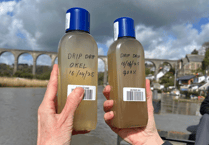THE controversial hydro-electric power scheme on the River Walkham at Sampford Spiney came under the spotlight again this week, when its developers built a fish pass — but not according to the approved drawings.
A planning application to build the hydro scheme by Abbotskerswell-based CGP South West was approved last year by Dartmoor National Park Authority, subject to conditions.
One of these was that before it was built, a fish pass had to be constructed on the existing weir but those opposing the scheme said the developers did not accurately follow these drawings. The DNPA and Environment Agency are due to discuss the situation this week to assess the latest position.
Stephen Belli, director of planning for Dartmoor National Park Authority, said: 'The current situation is that the fish pass as constructed is not wholly in accordance with the planning permission drawings approved. Neither is it in line with the license granted by the Environment Agency.'
The National Park Authority has informed the developers that the work they are doing is unauthorised and is currently working with the EA and the developers to find a solution. It has been made clear to the developers that any work they do is at their own risk.
A spokesman for the authority said that at this time 'it was not an enforcement issue.'
Mike Dunning, a spokesman for the Environment Agency added: 'We have issued three licences authorising the hydropower scheme. There have been issues with the construction of the fish pass, we are working closely with the licence holders to resolve these issues.
'The scheme has not yet been commissioned. The go live date is planned for early 2014.'
However, those against the hydro-electric scheme claim that the fish pass has been built in the wrong place, and say it is against both the plans for its planning consent and, much more importantly, the impoundment licence granted by the Environment Agency.
Pam Hayward, one of the protestors, said that, as built, the pass was less attractive to fish at its downstream entrance than it should have been. It is also much closer to the leat entrance at the upstream exit, with the result that fish are more likely to be swept into the leat rather than being able to swim freely upstream.
She said the structure had been not been constructed according to the plans and, because of the way the walls have been built, the flow of water is impeded and the pass is less efficient.
Furthermore, the condition imposed by the DNPA, that the construction should be built using a darkened concrete in order to soften its appearance in the river, had not been adhered to.
Miss Hayward said: 'The planning authority assured us the conditions they had attached to their consent were "bombproof".
'One would have hoped that such a contentious and high profile site would have been subject to the meticulous and careful guardianship of both authorities as the development took shape.
'If we allow developers to ride roughshod over planning consents and conditions in this way we make a mockery of the system. I look forward to hearing that both authorities are preparing to take vigorous enforcement action.'
'Fearing its impact on both the river and the ancient weir, we fought hard to stop this development happening at all. We were told it was a 'win-win' exercise by the Environment Agency, who would 'win' a superior fish pass on the Walkham — albeit at the cost of allowing a substantial abstraction of water — coupled with a 'win' of green energy for the developer. If nothing is done to rectify the current situation, the green energy will come at the cost of fish passage and there will be no 'win-win'.
In response to criticisms CGP (South West) say they have tried to comply with every requirement made by the authorities.
Tony Jackson, a director of CGP, told the Times: 'It is true to say that we are in discussion with both Dartmoor National Park Authority and the Environment Agency about minor variations in the final build of the fish pass. These discussions are not yet resolved but the evidence provided by our professional advisors leads us to believe that these minor changes are not material to the structure or functionality of the fish pass.
'The assertion by protestors that the fish pass is less attractive to fish‚ is pure speculation. The fish pass has been constructed to a design recommended by the Environment Agency Fish Pass Panel and we therefore expect it to function accordingly. Early evidence would appear to support the fact that the pass is working well.
'The stain used to colour the concrete was to the precise specification agreed with the DNPA planning officer as part of the planning application process.'




Comments
This article has no comments yet. Be the first to leave a comment.